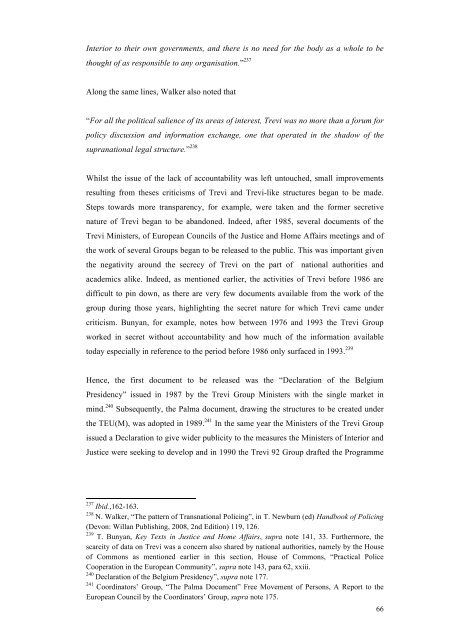The evolution of European Union criminal law (1957-2012)
The evolution of European Union criminal law (1957-2012)
The evolution of European Union criminal law (1957-2012)
You also want an ePaper? Increase the reach of your titles
YUMPU automatically turns print PDFs into web optimized ePapers that Google loves.
Interior to their own governments, and there is no need for the body as a whole to be<br />
thought <strong>of</strong> as responsible to any organisation.” 237<br />
Along the same lines, Walker also noted that<br />
“For all the political salience <strong>of</strong> its areas <strong>of</strong> interest, Trevi was no more than a forum for<br />
policy discussion and information exchange, one that operated in the shadow <strong>of</strong> the<br />
supranational legal structure.” 238<br />
Whilst the issue <strong>of</strong> the lack <strong>of</strong> accountability was left untouched, small improvements<br />
resulting from theses criticisms <strong>of</strong> Trevi and Trevi-like structures began to be made.<br />
Steps towards more transparency, for example, were taken and the former secretive<br />
nature <strong>of</strong> Trevi began to be abandoned. Indeed, after 1985, several documents <strong>of</strong> the<br />
Trevi Ministers, <strong>of</strong> <strong>European</strong> Councils <strong>of</strong> the Justice and Home Affairs meetings and <strong>of</strong><br />
the work <strong>of</strong> several Groups began to be released to the public. This was important given<br />
the negativity around the secrecy <strong>of</strong> Trevi on the part <strong>of</strong> national authorities and<br />
academics alike. Indeed, as mentioned earlier, the activities <strong>of</strong> Trevi before 1986 are<br />
difficult to pin down, as there are very few documents available from the work <strong>of</strong> the<br />
group during those years, highlighting the secret nature for which Trevi came under<br />
criticism. Bunyan, for example, notes how between 1976 and 1993 the Trevi Group<br />
worked in secret without accountability and how much <strong>of</strong> the information available<br />
today especially in reference to the period before 1986 only surfaced in 1993. 239<br />
Hence, the first document to be released was the “Declaration <strong>of</strong> the Belgium<br />
Presidency” issued in 1987 by the Trevi Group Ministers with the single market in<br />
mind. 240 Subsequently, the Palma document, drawing the structures to be created under<br />
the TEU(M), was adopted in 1989. 241 In the same year the Ministers <strong>of</strong> the Trevi Group<br />
issued a Declaration to give wider publicity to the measures the Ministers <strong>of</strong> Interior and<br />
Justice were seeking to develop and in 1990 the Trevi 92 Group drafted the Programme<br />
237 Ibid.,162-163.<br />
238 N. Walker, “<strong>The</strong> pattern <strong>of</strong> Transnational Policing”, in T. Newburn (ed) Handbook <strong>of</strong> Policing<br />
(Devon: Willan Publishing, 2008, 2nd Edition) 119, 126.<br />
239 T. Bunyan, Key Texts in Justice and Home Affairs, supra note 141, 33. Furthermore, the<br />
scarcity <strong>of</strong> data on Trevi was a concern also shared by national authorities, namely by the House<br />
<strong>of</strong> Commons as mentioned earlier in this section, House <strong>of</strong> Commons, “Practical Police<br />
Cooperation in the <strong>European</strong> Community”, supra note 143, para 62, xxiii.<br />
240 Declaration <strong>of</strong> the Belgium Presidency”, supra note 177.<br />
241 Coordinators’ Group, “<strong>The</strong> Palma Document” Free Movement <strong>of</strong> Persons, A Report to the<br />
<strong>European</strong> Council by the Coordinators’ Group, supra note 175.<br />
66
















